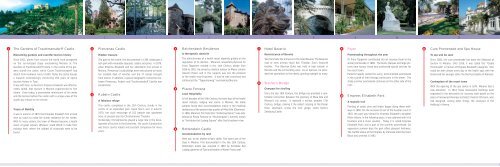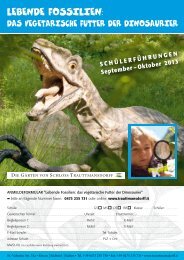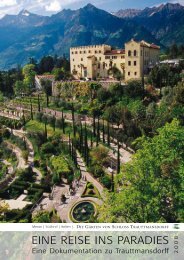Sissi's Path – Merano City Map - The Gardens of Trauttmansdorff
Sissi's Path – Merano City Map - The Gardens of Trauttmansdorff
Sissi's Path – Merano City Map - The Gardens of Trauttmansdorff
Create successful ePaper yourself
Turn your PDF publications into a flip-book with our unique Google optimized e-Paper software.
1<br />
1 2 3 4 5 6 7 8 9 10 11<br />
<strong>The</strong> <strong>Gardens</strong> <strong>of</strong> <strong>Trauttmansdorff</strong> Castle<br />
Blossoming gardens and eventful tourism history<br />
Since 2001, plants from around the world have prospered<br />
on the sun-blessed slope overlooking <strong>Merano</strong> at <strong>The</strong><br />
<strong>Gardens</strong> <strong>of</strong> <strong>Trauttmansdorff</strong> Castle. In the centre <strong>of</strong> the gardens<br />
stands the castle, which Count <strong>Trauttmansdorff</strong> had<br />
rebuilt from medieval ruins in 1850. Today the castle houses<br />
a museum entertainingly chronicling 200 years <strong>of</strong> alpine<br />
tourism history in Tyrol.<br />
It was with Sissi, as Austria’s Empress Elisabeth was affectionately<br />
called, that tourism in <strong>Merano</strong> experienced its first<br />
bloom. Even today, a promenade reminiscent <strong>of</strong> her walks<br />
and the terrace before the castle (with a unique view <strong>of</strong> the<br />
south) pay tribute to her throne.<br />
Traces <strong>of</strong> Nobility<br />
It was in autumn <strong>of</strong> 1870 that Empress Elisabeth first arrived<br />
here by coach to make her winter residence for her health.<br />
With its many visitors, the town <strong>of</strong> <strong>Merano</strong> became a health<br />
resort <strong>of</strong> great renown: Whoever could afford it made their<br />
holidays here, where the noblest <strong>of</strong> aristocrats were to be<br />
found.<br />
2<br />
3<br />
Pienzenau Castle<br />
Hidden treasure<br />
<strong>The</strong> path to this castle, first documented in 1394, leads past a<br />
lush park with venerable sequoias, cedars and pines. In 1870,<br />
when Empress Elisabeth and her attendants first arrived in<br />
<strong>Merano</strong>, Pienzenau’s outbuildings were restructured to house<br />
her sizeable fleet <strong>of</strong> vehicles and the 27 horses brought<br />
from Vienna. In addition, a special telegraphic connection between<br />
Pienzenau, Rubein and <strong>Trauttmansdorff</strong> Castles was<br />
established.<br />
Rubein Castle<br />
A fabulous refuge<br />
This castle, completed in the 12th Century, stands in the<br />
centre <strong>of</strong> an expanded park. Upon Sissi’s visit in autumn<br />
1870, her royal entourage <strong>of</strong> 102 people was quartered<br />
here, at present-day Via Christomannos <strong>The</strong>odor.<br />
Incidentally, Christomannos played a large role in the development<br />
<strong>of</strong> tourism in the Dolomites. His cousin Constantine<br />
was Sissi’s courtly reader and constant companion for many<br />
years.<br />
4<br />
5<br />
6<br />
Reichenbach Residence<br />
A therapeutic domicile<br />
<strong>The</strong> attractiveness <strong>of</strong> a health resort depends greatly on the<br />
reputation <strong>of</strong> its doctors. <strong>Merano</strong>’s renowned physician Dr<br />
Franz Tappeiner resided in this 14th Century abode from<br />
1854 to 1902. He served as medical advisor to Mayor Johann<br />
Valentin Haller, and in this capacity was one the pioneers<br />
<strong>of</strong> the health resort business. It was he who conceived and<br />
c<strong>of</strong>inanced the “Tappeinerweg” overlooking <strong>Merano</strong>.<br />
Piazza Fontana<br />
Local Hospitality<br />
In first decades <strong>of</strong> the 19th Century, the early days <strong>of</strong> the health<br />
resort industry, lodging was scarce in <strong>Merano</strong>; the noble<br />
patients found their accommodations mainly in the medieval<br />
residences <strong>of</strong> the present-day quarter <strong>of</strong> Maia Alta (Obermais).<br />
In 1869, <strong>Merano</strong>’s first hotel (the “Erzherzog Rainer”) was established<br />
at Piazza Fontana (or “Brunnenplatz”), formerly known<br />
as “Archduke Karl Ludwig Square” after Sissi’s brother-in-law.<br />
Rottenstein Castle<br />
Accommodation by rank<br />
Here too, at her brother-in-law’s castle, Sissi spent one <strong>of</strong> her<br />
stays in <strong>Merano</strong>. First documented in the late 13th Century,<br />
Rottenstein Castle was acquired in 1863 by Archduke Karl<br />
Ludwig, governor <strong>of</strong> Tyrol and brother <strong>of</strong> Kaiser Franz Josef.<br />
7<br />
8<br />
Hotel Bavaria<br />
Reminiscence <strong>of</strong> Bavaria<br />
Two lions flank the entrance to the hotel Bavaria. <strong>The</strong> Bavarian<br />
coat <strong>of</strong> arms animals recall Karl <strong>The</strong>odor, Sissi’s favourite<br />
brother. <strong>The</strong> Bavarian Duke was held in high esteem in<br />
<strong>Merano</strong> and the surrounding area: As an optician, he provided<br />
free operations to the needy, granting eyesight to many.<br />
Steinern Bridge<br />
Overpass for strolling<br />
Since the late 19th Century, this bridge has provided a comfortable<br />
connection between the greenery <strong>of</strong> Maia Alta and<br />
<strong>Merano</strong>’s city centre. It replaced a narrow, wooden 17th<br />
Century, bridge, making it the oldest crossing <strong>of</strong> the Passer<br />
River. Upstream, across the river gorge, stand historic<br />
Zenoburg Castle.<br />
9<br />
10<br />
Foyer<br />
Promenading throughout the year<br />
Dr Franz Tappeiner contributed this art nouveau foyer to the<br />
winter promenade in 1889. <strong>The</strong> busts, plaques and large pictures<br />
here honour those who performed special services for<br />
the resort town.<br />
Patients happily visited the sunny, wind-shielded promenade<br />
in the course <strong>of</strong> their therapy, particularly in the winter. <strong>The</strong><br />
shady summer promenade continues on the other side <strong>of</strong> the<br />
river.<br />
Empress Elisabeth Park<br />
A majestic trail<br />
Planting <strong>of</strong> cedar, pine and linden began along these walkways<br />
in 1860. On the occasion <strong>of</strong> visit <strong>of</strong> the Austrian court in<br />
1870, the park was named for Empress Elisabeth’s daughter<br />
Marie Valerie. In the following years, it was adorned with trick<br />
fountains and a music pavilion. Today it is called Empress<br />
Elizabeth Park, and is part <strong>of</strong> the summer promenade. On<br />
oppressive summer days the park <strong>of</strong>fers pleasant freshness.<br />
<strong>The</strong> marble statue <strong>of</strong> the Empress by Viennese artist Hermann<br />
Block was unveiled in 1903.<br />
11<br />
Cure Promenade and Spa House<br />
To see and be seen<br />
Since 1850, the cure promenade has been the lifeblood <strong>of</strong><br />
tourism in <strong>Merano</strong>. Until 1918, it was called the "Gisela<br />
Promenade" in honour <strong>of</strong> Empress Elisabeth’s daughter. Sissi<br />
could be seen almost every day at the health spas with her<br />
Gisela and her younger sister, the Duchess Sophie <strong>of</strong> Alençon.<br />
Centrepiece <strong>of</strong> the resort town<br />
With the opening <strong>of</strong> the spa centre in 1874, <strong>Merano</strong> had a<br />
new attraction. In 1914, these neoclassical buildings were<br />
expanded in the decorative art nouveau style based on the<br />
plans <strong>of</strong> renowned Viennese architect Friedrich Ohmann, who<br />
had designed, among other things, the courtyard <strong>of</strong> the<br />
H<strong>of</strong>burg in Vienna.
<strong>Merano</strong> has many stories, among them the tale <strong>of</strong> the beloved<br />
Austrian Empress Sissi and her love for the town <strong>of</strong> <strong>Merano</strong>.<br />
Inspired by the mild climate and the wealth <strong>of</strong> Mediterranean<br />
vegetation, the empress stayed in the emergent resort town on<br />
several occasions. Sissi enjoyed extended walks in and around<br />
<strong>Merano</strong>.<br />
Through quiet corners and old parks, past stately mansions and<br />
noble residences, Sissi’s <strong>Path</strong> leads from <strong>The</strong> <strong>Gardens</strong> <strong>of</strong><br />
<strong>Trauttmansdorff</strong> Castle into <strong>Merano</strong>’s city centre - or in the<br />
opposite direction. <strong>The</strong> trail is clearly marked with the title<br />
"Sissi’s <strong>Path</strong>”, and can easily be travelled with baby carriages or<br />
by wheelchair.<br />
We wish you an enjoyable time as you explore the trail and discover<br />
<strong>Merano</strong>’s unique flair.<br />
<strong>The</strong> <strong>Gardens</strong> <strong>of</strong> <strong>Trauttmansdorff</strong> Castle<br />
Via San Valentino, 51a<br />
39012 <strong>Merano</strong> <strong>–</strong> Italy<br />
Tel. +39 0473 235 730<br />
www.trauttmansdorff.it<br />
Open daily from 1 April through 15 November<br />
Administrative <strong>of</strong>fice <strong>of</strong> the spa town <strong>Merano</strong><br />
Corso Libertà, 35<br />
39012 <strong>Merano</strong> <strong>–</strong> Italy<br />
Tel. +39 0473 272 000<br />
www.meraninfo.it<br />
This project was realised by the city council <strong>of</strong> <strong>Merano</strong> and the <strong>Gardens</strong> <strong>of</strong> <strong>Trauttmansdorff</strong> Castle.<br />
www.reichert.it<br />
Sissi’s <strong>Path</strong><br />
1<br />
2<br />
3<br />
4<br />
5<br />
6<br />
7<br />
8<br />
9<br />
10<br />
11<br />
<strong>The</strong> <strong>Gardens</strong> <strong>of</strong> <strong>Trauttmansdorff</strong> Castle<br />
Via S. Valentino, 51a<br />
Pienzenau Castle (privately owned)<br />
Via Pienzenau, 6<br />
Rubein Castle (privately owned)<br />
Via <strong>The</strong>odor Christomannos, 38<br />
Residence Reichenbach (privately owned)<br />
Vicolo Reichenbach, 4<br />
Piazza Fontana<br />
Rottenstein Castle (privately owned)<br />
Corner Piazza Fontana/Via Scena 6<br />
Hotel Bavaria<br />
Vicolo della Chiesa, 15<br />
Steinerner Steg<br />
Wandelhalle<br />
Pure walking time: 45 min<br />
Total length <strong>of</strong> path: 3 km<br />
Altitude difference: 45 m<br />
Town Hall<br />
c<br />
2003 Municipality <strong>of</strong> Meran - GIS Service<br />
Empress Elisabeth Park<br />
Cure Promenade and Spa House<br />
Legend<br />
Castle Car park<br />
Church<br />
Taxi stand<br />
Public toilet<br />
Museum<br />
Hospital<br />
Tourist Info<br />
Camping area<br />
MERANO<br />
THERMAL<br />
BATHS<br />
N<br />
Sissi’s <strong>Path</strong><br />
On the trail from <strong>The</strong> <strong>Gardens</strong> <strong>of</strong> <strong>Trauttmansdorff</strong><br />
Castle to the heart <strong>of</strong> <strong>Merano</strong><br />
Empress Elisabeth (1837 - 1898)<br />
<strong>Merano</strong> - South Tyrol











